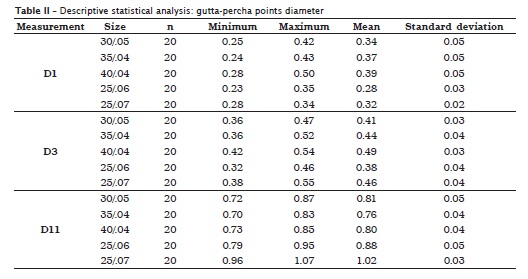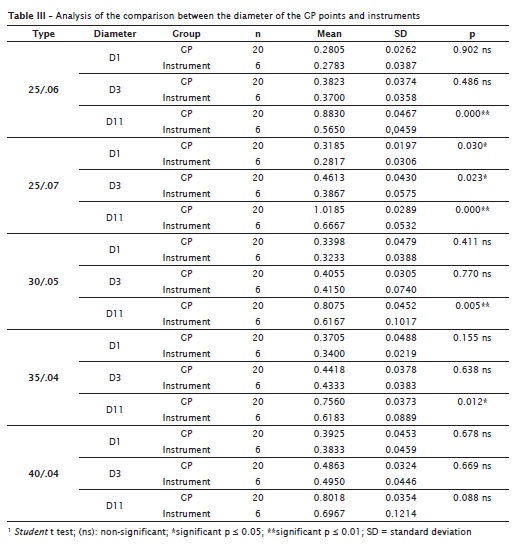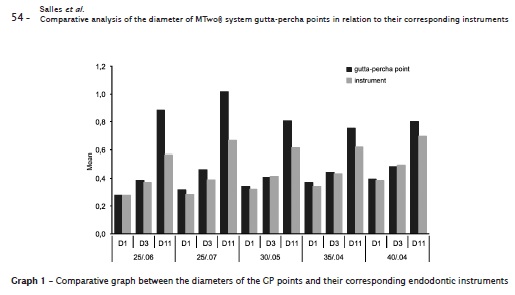Services on Demand
Article
Related links
Share
RSBO (Online)
On-line version ISSN 1984-5685
RSBO (Online) vol.10 n.1 Joinville Jan./Mar. 2013
ORIGINAL RESEARCH ARTICLE
Comparative analysis of the diameter of MTwo® system gutta-percha points in relation to their corresponding instruments
Alexandre Azevedo SallesI; Caroline Berwanger CordII; Taciane Sperb SonnemannII; Tiago André Fontoura de MeloII; Luis Eduardo Duarte IralaI; Elias Pandonor Motcy de OliveiraI
IDepartment of Dentistry, Lutheran University of Brazil – Canoas – RS – Brazil.
IIDepartment of Dentistry, São Leopoldo Mandic (Porto Alegre Unit) – Porto Alegre – RS – Brazil.
ABSTRACT
Introduction and Objective : This study aimed to compare the diameter of sizes 25/.06, 30/.05, 35/.04, 40/.04 and 25/.07 main gutta-percha point of MTwo® system in relation to their corresponding nickel-titanium instruments.
Material and methods: For this purpose, the measurements of both the main gutta-percha points and their corresponding instruments were obtained with the aid of a caliper at the positions D1, D3 and D11. Twenty points and six instruments of each size were used.
Results: Data were subjected to student t test, with a significance level of 5%. It could be observed that there was a variation in the diameter of the gutta-percha points in relation to the diameter of the instruments. At D1 and D3, size 25/.07 points had diameters significantly higher than their respective instruments. At D11, sizes 25/.06, 25/.07, 30/.05 and 35/.04 points also had significantly higher diameters. For size 40/.04 point, there were no statistically significant differences between the point and instrument diameters.
Conclusion: Most of the main gutta-percha points of MTwo® system analyzed in this study showed significantly greater diameters than those of their corresponding instruments. Only the size 40/.04 points did not present significant differences in diameter compared with their corresponding instrument.
Keywords: Endodontics; gutta-percha; root canal obturation.
Introduction
One of the fundamental rules guiding the step of endodontic obturation is the hermetic sealing of root canal.
Root canal obturation is achieved through the association of gutta-percha points with the endodontic cement. It is known that the cement reinforces the sealing capacity of obturation, filling the space existing among the dentinal walls and the gutta-percha points 11. If the main gutta-percha (GP) point adapts perfectly to the apical stop of the preparation, there will be a better sealing, therefore avoiding the extrusion of the filling material into the periapical tissues 1,7.
Accordingly, numerous studies have verified the relationship between the diameter of the gutta-percha points and the corresponding endodontic instruments.
Cunha et al. 2 analyzed size #30, #40 and #50 standardized gutta-percha points of three different brands. The points were measured through a gauge ruler, in which the points were inserted according to their taper to verify their locking. The authors concluded that all points, at greater or smaller degree, differed from their standardization at D0 position.
Additionally Aguiar et al. 1 conducted a study in which they used 720 main gutta-percha points of the first and second series of several batches of the following brands: Dentsply/Maillefer®, Tanari® and Endopoints®; and 660 K type endodontic instruments of 25 mm of length of the brands Dentsply®, Dyna® and Kerr®, to obtain the diameter correspondence at D0. The determination of the diameter at D0 was performed with the aid of a digital caliper. As a result, it was showed that 36% of the gutta-percha points did not have their D0 diameters in correspondence to the endodontic instruments.
In 2006, Cunningham et al. 3 evaluated size 30/.04 gutta-percha points of five different commercial brands: Diadent®, Lexicon®, Maillefer®, K3® and Maxima®. The measurement of the D0 diameter of each point was executed through a measuring microscope with precision of 0.001 mm. Because the ANSI/ADA Specification n. 78 established a variation of ± 0.07 mm for D0 in size #30 points, the acceptable pattern for the points measured at D0 would be of 0.23-0.37 mm. Therefore, the points measured were divided according to the following categories: 0.23 to 0.25 mm, 0.26 to 0.29 mm, 0.30 mm, 0.31 to 0.34 mm, and 0.35 to 0.37 mm. The taper of the points was determined from D3 and D16 diameter, through the diameter equation at D16 – diameter at D3 / distance between D3 and D16. Based on the results found for taper, the percentage difference for each point was calculated regarding to the taper informed by the manufacturer. The authors observed that there was a significant variability of the diameter and taper for the points evaluated; however, all results were within the limit accepted by the ANSI/ADA Specification n. 78, because they did not surpass ± 0.07 mm.
Also, Kunert et al. 7 analyzed through two gauge rulers of different brands, the adaptation at D0 of sizes F1, F2 and F3 gutta-percha points of ProTaper® system in relation to the NiTi instruments of the same system. The samples were then divided into three groups according to the situation assessed. The first group comprised gutta-percha points and instruments which exactly matched their orifice in the gauge ruler. The second group was composed of GP points and instruments which surpassed the measurement orifice of the ruler. And the third group comprised the GP points and instruments which locked previous to the ending of the orifice of calibration of the ruler. The authors found that none measuring rulers used exhibited ideal conditions for the assessment of the adaptation of the GP points and rotary instruments of the ProTaper® system. Additionally, it was seen that the GP points showed diameter variations at D0, without standardization.
Therefore, the aim of this study was to compare the diameter of sizes 25/.06, 30/.05, 35/.04, 40/.04 and 25/.07 gutta-percha points of MTwo® system in relation to their corresponding instruments.
Material and methods
Twenty gutta-percha points of each size (25/.06, 30/.05, 35/.04, 40/.04 and 25/.07) were evaluated, all within the same batch of the MTwo® system (VDW GmbH, Munich, Germany, batch 348702C). Also, six MTwo® system nickel-titanium instruments were analyzed for each size of GP point evaluated. Both the GP points and the instruments were assessed at D1 (1 mm short of the tip), D3 (3 mm short of the tip) and D11 (11 mm short of the tip).
To measure both the GP points and instruments, a gauge ruler (Dentsply/Maillefer) was placed onto a flat glass plate, along with a metallic millimeter ruler (Prisma), in order to match the measuring canals of both rulers. The two rulers were fixed with the aid of utility wax (Technew/Newwax), to avoid a possible displacement during the measurement. The site marking was performed with the aid of fine tip marker pen (Mercur) (figure 1).

After the marking of the sites previously selected, with the aid of a digital caliper (Stainless Hardened) the diameter measurements of the GP points and instruments were executed (figure 2). The procedure was performed twice for a single examiner and recorded on a specific sheet.

Results
Data were submitted to student t test for paired samples with level of significance set at 5%. Because in totality, 100 gutta-percha points were measured (each GP point, at each site – D1, D3 and D11 –, was measured twice by the same examiner), the statistical analysis employed the means between the 1st and 2nd measurement and then the standard deviation was obtained (table I). Thus, the results of the Student t test for paired samples, it was verified that there were no statistically significance differences between the two measurements.

For the following analyses, the mean of the 1st and 2nd measurement values was used. Table II shows the diameter mean and standard deviation of the GP points at each site (D1, D3 and D11).

These means were then submitted to student t test to compare the diameter means of the GP point and instruments (table III).

Based on the results, it could be verified that there was a variation in the diameter of the main GP points in relation to the diameter of the instruments. At D1 and D3, size 25/.07 GP points showed statistically greater diameters than those of the instruments. Also at D11, sizes 25/.06, 25/.07, 30/.05, 35/.04 GP points exhibited significant greater diameters than those of the instruments. For size 40/.04 GP points, it were not observed statistically significant differences between the diameters of GP points and instruments.
The differences in the diameter between the GP points and instruments are seen in graph 1.

Discussion
Currently, the dental market displays a great variety of rotary nickel-titanium instruments, which have made easy the process of shaping of the root canals. Accordingly, gutta-percha points with the same sizes of the rotary instruments have been found. However, as far as we are concerned, the literature did not report any study on the shape of the gutta-percha points of MTwo® system, reason for which we opted for their assessment.
According to Pesce and Medeiros 9, the lack of standardization and uniformity of both endodontic instruments and gutta-percha points may cause the endodontic treatment failure. The tridimensional sealing of the root canal with endodontic filling material up to the working lenght decreases the likelihood of microorganism development 13. Consequently, it is necessary that the gutta-percha point used as master cone have its D1 diameter as closer as possible to the position corresponding to the instrument used to construction the apical stop 12. This correspondence between the diameter of the GP points and the instruments will promote a proper locking of the master cone at D1, because is at this diameter that the apical stop is constructed.
Moreover, considering the methodology employed in this present study, we opted to execute the measurement of the GP points by placing the caliper perpendicularly to each point, aiming to obtain the greatest diameter of each site marked. In the study of Waechter et al. 12 the digital caliper was placed parallely to each gutta-percha point, unlikely to the methodology of this present study and therefore not being able to obtain the greatest diameter of the site to be measured.
Additionally, the results obtained in the study may exhibit some variability possibly because of dimensional alterations in the gutta-percha points caused by the thermal conditions at the moment of the diameter measurement. Because the gutta-percha points are flexible structures, it is worth noting that the obtainment of the measurements with the digital caliper is extremely difficult: it is easy to alter a measurement by greater or smaller pressure on the caliper against the gutta-percha point.
Concerning to the result analysis, it was verified a lack of statistical significant correspondence between the diameters of the GP points and the rotary instruments of MTwo® system. Kunert et al. 7, by assessing the ProTaper® system, also found lack of correspondence between the diameters of the GP points and the rotary instruments within a same system.
Therefore, we verified through the results of this present study and other studies such as those of Davidowicz et al. 4, Moule et al. 8, Kopper et al. 6 and Santana et al. 10 that GP points so-called standardized have, at greater or smaller degree, variations in relation to the diameter specified.
The lack of compatibility of the main gutta-percha point with the endodontic instrument taper, which sometimes is not clinically realized by the clinicians, is capable of causing either over-obturation or under-obturation and it may lead to failure at long-term 5.
Conclusion
Based on the results of this present study, it was observed that most of the gutta-percha points of MTwo® system analyzed exhibited significant higher diameters than those of the corresponding endodontic instruments. Only size 40/.04 gutta-percha points did not show statistically significant differences of their diameters when compared with their corresponding instrument.
References
1. Aguiar CM, Cavalcanti JSC, Coelho KC. Vedamento apical pós-tratamento endodôntico. RGO. 2004;53(4):281-4. [ Links ]
2. Cunha RS, Fontana CE, Bueno CES, Miranda ME, Höfling RTB, Bussadori SK. Avaliação do diâmetro D0 de cones estandardizados de diferentes marcas comerciais através de uma régua calibradora. RGO. 2003;51(4):215-8. [ Links ]
3. Cunningham KP, Walker MP, Kulild JC, Lask JT. Variability of the diameter and taper of size #30, 0.04 gutta-percha cones. J Endod. 2006;32(11):1081-4. [ Links ]
4. Davidowicz H, Moura AAM, Strefezza F. Avaliação do diâmetro "D0" de cones de guta-percha estandardizados e calibrados comparados com limas tipo "K" através do microscópio comparador. Rev ABO Nac. 1994;2(3):181-5. [ Links ]
5. Fachin EVF. Considerações sobre insucessos na endodontia. Rev Fac Odontol Porto Alegre. 1999;40(1):8-10. [ Links ]
6. Kopper PMP, Tartarotti E, Pereira CC, Figueiredo JAP. Estudo da padronização de cones de guta-percha de três marcas comerciais. RGO. 2007;55(2):123-6. [ Links ]
7. Kunert GK, Melo TAF, Oliveira EPM, Barletta FB. Avaliação da adaptação de cones estandardizados de guta-percha ProTaper através de duas réguas calibradoras. Rev Assoc Paul Cir Dent. 2008;62(4):309-13. [ Links ]
8. Moule AJ, Kellaway R, Clarkson R, Rowell J, Macfarlane R, Lewis D et al. Variability of master gutta-percha cones. Aust Endod J. 2002;28(1):38-43. [ Links ]
9. Pesce HF, Medeiros JMF. Avaliação comparativa da qualidade do selamento marginal quando do preparo apical com dois tipos de instrumentos. Rev Odontol UNICID. 1998;10(1):33-7. [ Links ]
10. Santana MB, Sponchiado Jr EC, Garcia LFR, Marques AAF, Garrido ADB. Tip diameter of 0.04 and 0.06 tapered gutta-percha points from different commercial brands. Arch Oral Res. 2011;7(2):157-60. [ Links ]
11. Scelza MFZ, Soares J, Maciel ACC. Avaliação de alguns cimentos endodônticos quanto à obstrução dos túbulos dentinários. RPG. 2005;12(3):330-5. [ Links ]
12. Waechter F, Antunes RO, Irala LED, Limongi O. Avaliação comparativa entre o diâmetro de cones estandardizados e cones secundários B8 calibrados por régua calibradora, distando 1 mm das suas pontas (D1). RSBO. 2009;6(1):34-43. [ Links ]
13. Zanoni EMS, Leonardo MR, Lia RCC, Tagliavini RL. Espaços vazios nas obturações endodônticas. RGO. 1988;36(3):232-9. [ Links ]
 Corresponding author:
Corresponding author:
Tiago André Fontoura de Melo
Rua Lucas de Oliveira, n. 336, apto. 206 – Petrópolis
CEP 90440-010 – Porto Alegre – RS – Brasil
E-mail: tafmelo@gmail.com
Received for publication: July 19, 2012
Accepted for publication: August 12, 2012













